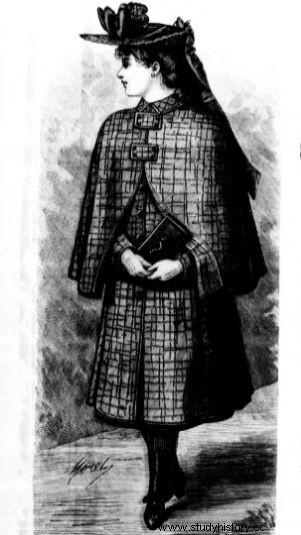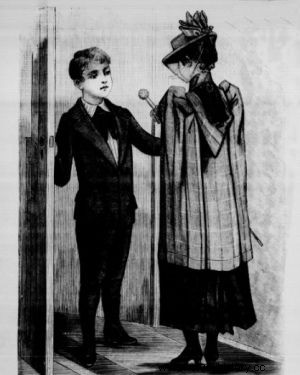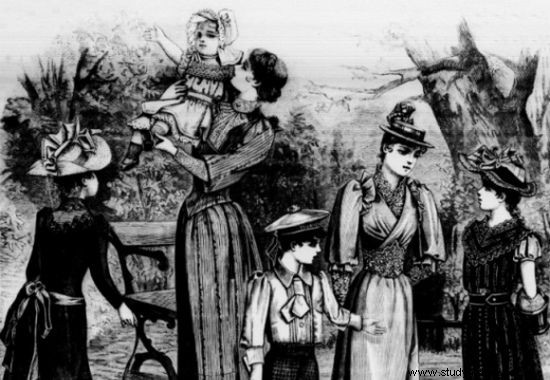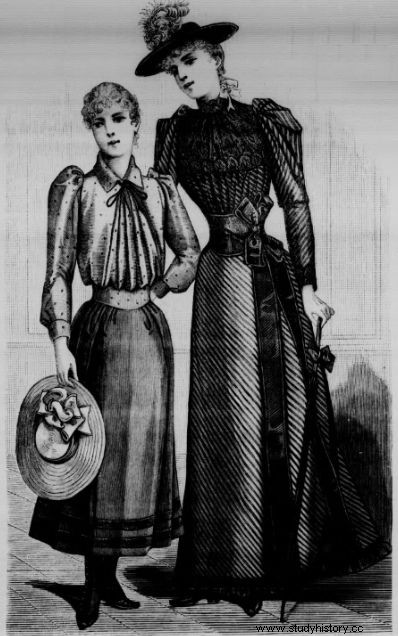She was to be a good Christian and obedient daughter, and in the future a prudent woman, faithful spouse and mother:tender without weakness, nevertheless constant, without obstinacy, decent and foreseeing. Such tasks for a young girl who just becomes a woman are mentioned by the author of the educational guide, a certain Sauvan. However, a teenager from a century and a half had a hard life.
When a little girl slowly ceased to be a little girl, a lot changed in her life. She wore different outfits, she had a different position at home, her daily activities were different than before, and she had completely new expectations. At the age of ten, the time of childhood games was over, and preparations for the role of the ideal wife, mother and housewife began.
A virgin from a good home starts education
While her brothers at schools (or under the supervision of tutors) dealt with Latin, mathematics, geography and other equally complex scientific disciplines, the young lady - educated at home - had a much easier education. The basic skills she had to acquire were nice and neat writing and the simplest form of calculations.

In fact, it was fitting for her to take her reading with her for walks, preferably censored by her mother.
In addition, she should have some knowledge of her native history, not much of universal history, of natural history, not much of geography. It would also be appropriate for her to learn to chatter in foreign languages and, of course, to read.
It was recommended that the young lady should not read too much, God forbid, books on medical topics (they may contain expressions inappropriate for a young lady) and romances (after all they evoke passions, and their reading threatens the future herd), rather fairy tales, decent novels, occasional speeches and the lives of saints.
However, when it comes to calculus (yes, talking about learning mathematics would be really exaggerated here), the young lady had to be satisfied in practice with the knowledge of four activities:addition, subtraction, multiplication and division. However, in order not to count in a vacuum, it was recommended that the young lady should count everything on examples useful later in the household:measures, weights, servants' salaries and an exemplary household budget.
Elements of chemistry were also introduced, of course in the dimensions corresponding to the needs of the lady of the house (dyeing canvases or the production of candles), physics (they were taught about heat, fire, electricity, light, colors) or laws (basic concepts, such as a will or property).
The practical education of the girl was very important. A common opinion was that helping a mother in the duties of a housewife is a desirable pastime for teenagers. It was the mother who was to watch over the "female" education of her adolescent daughter. From her, the girl was to learn modesty, thrift, good manners, manners, tradition and love for others.
In practice, her daughter had to accompany her in many household chores, learn under the watchful eye of her mother of needlework, cooking, planning time and money, mending clothes, sewing dresses, making reasonable supplies, managing the service and so on and so on ... to learn to play an instrument, dance, drawing lessons? Of course, the rare playtime was a reward, not a child's or a young girl's right.
Behavior of a young lady
Nineteenth-century authors of textbooks for women believed that a lady should be gentle, neat, modest, gentle, self-sacrificing, hardworking, strong, righteous, submissive, patient, and innocent. In order to cram such a set of features into a young head, one had to start as early as possible, after all, with what the shell of a youth ... From an early age, the future wife and mother were shaped. Girls were taught to speak to their parents with humility and love, always politely and gently. In every situation, they were to be obedient, nurture their relatives during illness, ask their parents for advice on any matter and find newer and newer ways to please them.

Even my dear cousin did not look into the eyes, and even from behind the veil.
They were also supposed to respect other relatives, especially grandparents. On this one issue, the basic educational mistake was sometimes inculcating some of the fledglings only manners useful for shining in salons, disregarding respect for age and life experience. The authors of textbooks of good manners in unison proclaimed that a teenage girl should be caring and caring towards her grandparents, have time and a good word for them, and be able to use their knowledge and experience.
Girls were supposed to behave modestly with the gentlemen. It was inconceivable to look boldly at a man, especially a stranger, in the eye. A lady from a good home was to be restrained in her behavior and expect the same from the man with whom she was staying. When the bachelor went a little wild and, for example, took her by the hand, she should move away from him immediately, or preferably walk away coldly, otherwise she might be considered vain, flirtatious, even ill-mannered. As Małgorzata Stawiak-Ososińska writes, in the book "Ponętna, submissive, accurate ...", During the spins, the girl was advised not to smile, otherwise she would not be able to get rid of the intruder.
This article has more than one page. Please select another one below to continue reading.Attention! You are not on the first page of the article. If you want to read from the beginning click here.
Maturation
There comes a time in every girl's life when she begins to become a woman. Her body changes, sometimes the body simply goes crazy in the world. One of the signs of this "revolution" is the start of menstruation.

In a 19th-century family, everyone knew their place, behaved according to age and was dressed according to age (source:public domain).
A century and a half ago, schools did not distribute "handbooks for girls", did not make teenagers aware of the changes taking place in their bodies, and in practice it was often waited until the last moment. Many mothers have not even tried to explain them to her daughter. Growing up, she was left with stealthy spying, secret reading from books, etc. However, if the teenage girl did not find any information and one day she just started bleeding, she could eat fear healthily, reading the usual physiological process as a life-threatening hemorrhage ...
The women and girls of that time did not have such small amenities as tampons, sanitary napkins, or all kinds of painkillers. Moreover, the best way to deal with a woman's ailments was seen in fulfilling household duties more diligently than usual.
A teenager who was just starting to menstruate had to learn a lot of things, including herbal mixtures that could relieve her ailments, learn to maintain hygiene, and, if necessary, methods to accelerate bleeding, about which the already mentioned Małgorzata Stawiak-Ososińska writes (e.g. soaking feet in lukewarm water mixed with salt or ash, submerging them to the knees so that "this way the blood will be drawn downwards").
Hygiene
Due to their gender, girls were used to more care for hygiene than boys from an early age. The ladies were advised to wash their hands several times a day, in addition to scrubbing their face, neck, neck and breasts with lukewarm water every morning, wiping sweat, etc. old yellowish patches of sweat under his armpits. Another important activity was washing the feet frequently. Its neglect, in addition to its foul smell, could lead to mycosis, calluses, ulcers and other such pleasures.

Without handbooks, the internet, and other favors, mum was the best source of information about puberty for the adolescent girl.
In order to maintain a beautiful skin, exposure to the sun should be avoided. Freckles were the little insidious pursuers of nineteenth-century virgins. There were a lot of ways to get rid of them in beauty guides (as was the case with pimples and blackheads, which are still the bane of teenagers of both sexes today), and it never occurred to anyone that these darker spots added beauty. In general, for the skin to be delicate and healthy, you should wash your face with milk, almond oil or diluted cream (personally, I would rather prepare almond marshmallows from these ingredients).
Without running water, in a time when decent shampoo was out of the question, almost all women had long hair. Every girl, from an early age, knew how to wash light and dark hair, when to tie her hair, how to prepare it before going to bed, and with age she even learned how to dye it if necessary.
Our great-great-grandmothers lived completely differently to us. They did not have a million amenities that became so obvious to us as to be imperceptible. They had to look after their beauty without having access to a large selection of cosmetics. They were good at sewing and mending clothes, though they wore several layers of clothing instead of a T-shirt and jeans. Not having a refrigerator, mixer or electric oven, they prepared delicious dishes for their loved ones. And yet it was possible!
Source:
- Elżbieta Kowecka, In the living room and in the kitchen. A story about the material culture of Polish palaces and manors in the 19th century. , Zysk i S-ka Publishing House, Poznań 2008.
- Małgorzata Stawiak-Ososińska, Seductive, submissive, accurate ... The ideal and image of a Polish woman of the first half of the 19th century (in the light of contemporary guides) , Impuls, Krakow 2009.
- P. Sauvan, Cautions and Advice for Mothers and Teachers , Warsaw 1843.
- "Ivy", No. 21-22 (1892).
